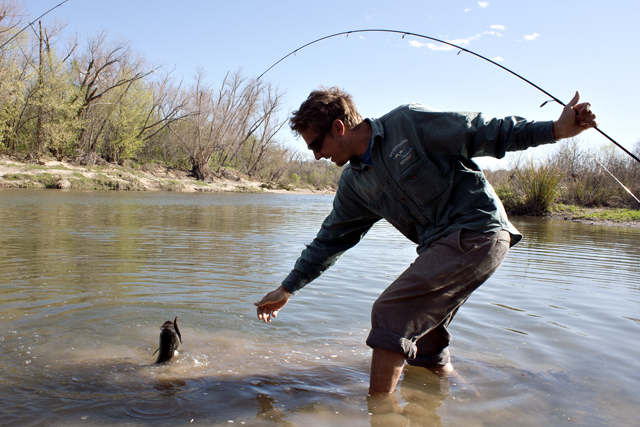Texas at the Epicenter of ‘Lunker’ Bass Fishing

Jonathan Clarkson, an angler on the Colorado River, bends to pick up a largemouth bass. The Toyota ShareLunker program in Texas propagates only giant largemouth bass to improve sport fishing. Photo by David Barer.
By David Barer
For Reporting Texas
It all began with Ethel, a largemouth bass so famous that when she died at 19 years of age 1,500 people attended her funeral. She was named after the ornery mother-in-law of the angler who caught her in Lake Fork, Texas, and now her legacy lives on through America’s first, and most successful, bass-breeding program.
In 1986, Mark Stevenson landed Ethel, whose 17.6-pound body drew the fishing world’s attention to Texas. The fish’s notoriety led to the creation of the Toyota ShareLunker Program, a bass-breeding program located at the Texas Freshwater Fisheries Center in Athens and dedicated to breeding lunker bass – weighing at least 13 pounds.
Run by the Texas Parks and Wildlife Department, the program encourages anglers to donate their behemoth bass to the Athens hatchery’s Lunker Bunker, a state-of-the-art facility and the epicenter of big-bass breeding in Texas. The goal is to release the offspring back into the wild to create populations of lunkers in lakes across Texas. Since the program began, 527 big bass from 63 different Texas lakes have been handed over to the ShareLunker program.
Program manager David Campbell transported Ethel to a Tyler hatchery 26 years ago in an unsuccessful attempt to breed her. Since then, he says he’s seen it flourish beyond his expectations. His quest: He wants a Texas bass to break the freshwater fishing record of 22.4 pounds, held by a bass caught in Georgia in 1932 and one in Japan in 2009.
“The ultimate goal is to produce a world record,” said Campbell, now a 46-year veteran of the Texas Parks and Wildlife Department. Campbell didn’t care about world records when the program began because he wasn’t sure it would gain traction. Huge bass had never been bred in captivity and asking an angler to fork over the catch of a lifetime seemed ludicrous.
“The first time I went and stuck my hand out and asked the angler if he’d loan me his big catch, I thought he’d cut my arm off at the elbow,” said Campbell.
When fish arrive at the Lunker Bunker, wildlife department biologists check them for infections before genetically testing and tagging them. Several of the lunkers have been caught twice, proving fish caught and eventually returned to their home lakes can survive the experience. If tests determine the lunkers to be pure Florida largemouth, they will be bred at the hatchery.
The program owes its success to the ’70s-era stocking of Texas lakes with Florida largemouth, a subspecies of the regular largemouth. The Florida bass grow larger and live longer than native Northern and Guadalupe largemouth bass. Any bass donated to the program that is not a pure Florida largemouth will not be bred and the angler that caught the bass can decide to have the fish released or let the wildlife department keep it.
Once breeding occurs, the fingerlings are released back into lakes where ShareLunkers have been previously caught. Each year ShareLunker raises 70 million koi goldfish to feed the resident population.
The program has been a process of trial and error for Campbell and his team. One bass froze in Campbell’s truck on a long drive to East Texas from Lake Allen Henry near Lubbock, he says. Another time Campbell sutured a bass’s broken jaw shut and force-fed the fish for two months. When he cut the stitches out the jaw fell back open, still broken.
Still, the ShareLunker program is gaining national prominence. “We’ve had five or six state agencies send people to the fisheries down here trying to determine … what worked for us and what they can do in their state to create something similar,” said Campbell. “I don’t know of any of them that have made it.” So far, 20 out-of-state anglers have donated their Texas bass to ShareLunker.
Big bass bring big numbers of anglers to the lakes where they’re caught, a boost to local economies. Lake Fork, just east of Dallas, is by far the state’s largest producer of huge bass, with 248 ShareLunkers donated. But every few years, a different lake produces a bumper crop of lunkers. In 2010 and 2011, it was O.H. Ivie Lake near San Angelo, where a bass weighing 16.08 was caught.
Marcos De Jesus, a freshwater fisheries biologist with the Texas Parks and Wildlife Department, says Lake Austin might be in for an epic year. He thinks there was a great “year-class,” a major spawning event, about 12 years ago. Now, those bass are reaching ShareLunker size.
“If you look at the history of the ShareLunker program, it’s one of the top producers” of ShareLunker bass per acre of lake, said De Jesus of relatively small Lake Austin, which is only about 1,500 acres. In January 2011, T.J. Nissen caught the largest bass ever hauled from Lake Austin – 16.03 pounds and 28.25 inches long. Even without a world record, the ShareLunker program has been deemed a success by anglers and biologists alike.
“I think if nothing else it’s something really fun for a recreational fisherman,” Nissen said. “We grow up watching Bassmasters on TV and seeing all these guys go out there and fish for a living. Well, this is an accomplishment that the average guy can go and get.”
This article was corrected to include mention of a record-setting bass caught in Japan.